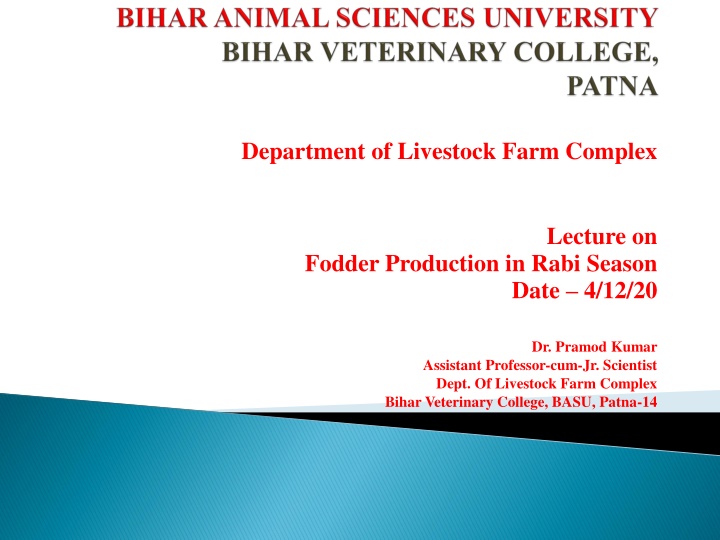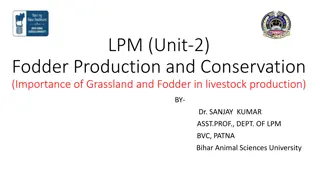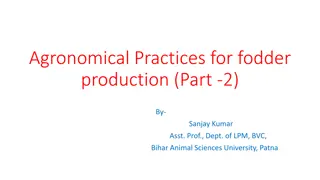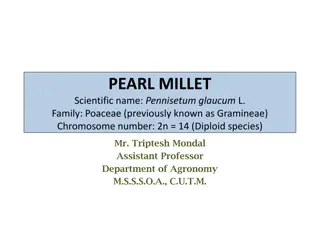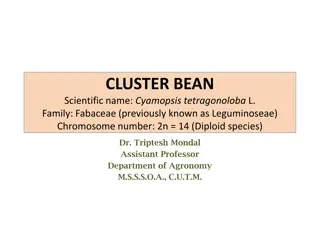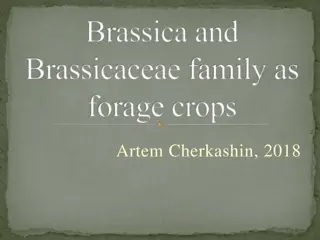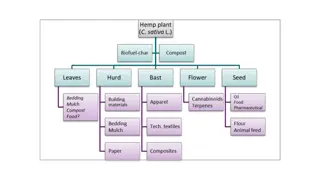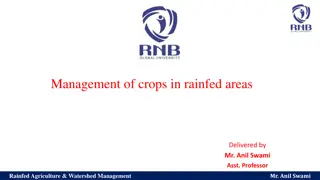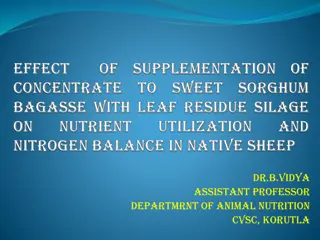Berseem: A Nutritious Rabi Crop for Fodder Production in India
Berseem, a major rabi fodder in India, is an annual crop with high protein content grown in winter and harvested in spring. It is a valuable forage crop known for improving soil fertility and providing high-quality nutrition for livestock. The crop's varieties, cultivation practices, and agronomic characteristics are detailed in this informative lecture.
Download Presentation

Please find below an Image/Link to download the presentation.
The content on the website is provided AS IS for your information and personal use only. It may not be sold, licensed, or shared on other websites without obtaining consent from the author.If you encounter any issues during the download, it is possible that the publisher has removed the file from their server.
You are allowed to download the files provided on this website for personal or commercial use, subject to the condition that they are used lawfully. All files are the property of their respective owners.
The content on the website is provided AS IS for your information and personal use only. It may not be sold, licensed, or shared on other websites without obtaining consent from the author.
E N D
Presentation Transcript
Department of Livestock Farm Complex Lecture on Fodder Production in Rabi Season Date 4/12/20 Dr. Pramod Kumar Assistant Professor-cum-Jr. Scientist Dept. Of Livestock Farm Complex Bihar Veterinary College, BASU, Patna-14
Rabi crops or rabi harvest are agricultural crops that are sown in winter and harvested in spring in india. The term is derived from the arabic word spring . These came from to used in india with ascent of the mughal empire in the indian subcontinent and have widly used ever since. The rabi crop are sown around mid-november, prreferably after the monsoon rains are harvesting begins in february/march. The crops are grown either with rain water that has percolated into the ground or using irrigation.. A good rain in winter spoils the rabi crops but is good for Kharif crops.
The major rabi fodders in india is :- Berseem(trifolium alexandrinum) lucerne(medicago sativa) Oats(Avena sativa) Morara (Melilotus indica all) Senji or indian clover(Melilotus parviflora
Berseem is an annual growing to 80-120 cm height. Stems are hallow and succulent with numerous leaves. It is a native of Asia minor and introduced to India from Egypt. Adapted to subtropical and temperate climate, grows well under irrigated conditions in north India. Berseem can be used as a soil fertility builder, since it can improve the physical condition of the soil. It a green soiling and hay crop and is rated as a very high nutritious forage. It contains 15-20 % protein on dry matter basis.
Sl. No 1. Varieties Area of cultivation GFY T/ha Mescavi All berseem growing areas of the country All berseem growing areas of the country 70-90 2. Wardan(S-99-1) 80-110 3. BL-1 and BL-10 Punjab, Himachal and Jammu 80-100 4. 5. Jawhar berseem-1 Madhya pradesh UPB-110 85-90 55-70 Southern zone- AP,karnataka,maharastra,south and west MP Hill and sub temperate 6. BL-2 and BL-22 80-105 7. 8. JB-2 and 3 IGFRI-S-99-1 Central India Central India 70-95
Season It is a rabi season crop. October november sowing. Soil- grows in all types of soil in regions with mild cold winter.tolerant to alkali condition. Field preparation plough the field once with iron plough and twice or more with country plough to obtain good tilth.form ridges and furrows 6 cm long and 50 cm aparts or beds of 5x4m or 20 m2 depending upon the availability of water and slop of the land. Manuring Responds well to phosphorus fertiliser application. Seeds and sowing- a. seed rate- 20-25 kg/ha. b. seed treatment seed is soaked over night in water. Rhizobilal inoculation of the seed is essentiak for field. c.spacing 20x20cm or broadcast in standing water held in small compartment. Irrigation the crops need copious irrigation. Harvesting- First harvesting can made 45 days after sowing and subsequent harvests at 30 days interval. Green fodder yield 50-100 t/ha. 1. 2. 3. 4. 5. 6. 7. 8.
Lucerne is a herbaceous, deep rooted, perennial legume with trifoliate wedge shape leaves. The plant is native of europe, asia and africa but presently distributed all over the world. It is considered as the queen of forage crops and grown mostly under irrigated condition in india. Once grown it continues to supply nutritious fodder for 3- 4 years. Lucerne is highly nutritious and palatable.it contains about 15-18 % protein. It is sown both as an annual and perennial crops. Farm animals fed exclusively on lucerne suffer from bloat due to the saponin glucoside and to avoid this green lucerne should be chaffed and mixed with equal quantity of dry bhusa.
Sl. No 1. Varieties Area of cultivation GFY T/ha Co-1 (P) Tamilnadu, karnataka and AP 60-80 2. Anand-1 and -2 Gujarat, Rajasthan, Madhaya Pradesh 80-95 3. Sirsa-9 or T-9 (P) Whole country 80-95 4. LL composite- 3(A) LL composite-5 Whole country 80-95 5. punjab 70 - 105 6. Anand -3 (A) Himachal pradesh and Gujarat 60-85 7. RL-88, Sri Ganganagar, IGFRI-S- 244,IGFRI-S-54 Whole country 90-130
Season Grown mostly as irrigated crop and October november or July-December sowing are preferred. Soil- Loamy soil with good drainage. Field preparation plough the field once with iron plough and twice or more with country plough to obtain good tilth.form ridges and furrows 6 cm long and 25 cm aparts or beds 10- 20 m2 depending upon the availability of water and slop of the land. Manuring FYM-or Compost-25t/ha, Nitrogen 25kg/ha, phosphorus-120 kg/ha, potassium 40 kg/ha. Seeds and sowing- a. seed rate- 20-25 kg/ha. b. seed treatment seed is soaked over night in water. Rhizobilal inoculation of the seed is essentiak for field. c.spacing - 25 cm. Irrigation the crops need copious irrigation. Harvesting- First harvesting can made 75-90 days after sowing and subsequent harvests at 25-30 days interval. Green fodder yield 80-100 t/ha in 12-13 cuttings. 1. 2. 3. 4. 5. 6. 7. 8.
A stout erect annual cereal growing to height of 120 cm. Widely distributed in temperate and subtropical countries, particularly in the western countries. The fodder is nutritious and especially suitable for milch animals and horses It can be fed either green soiling or converted into hay or silage. It contains 7-9% of protein. Kent variety is very popular in UP when fed exclusively it can support a milk production of 3 kg.
Sl. No 1. Varieties Area of cultivation GFY T/ha HFO-114 All oats growing areas of the country 50-60 2. Kent All oats growing areas of the country 50-60 3. OS-6 and OS-7 All oats growing areas of the country 40-57 4. Weston-11, Fulgham, FOS1/29, Algerian OL-9 All oats growing areas of the country 40-45 5. North, North West and South hills, Haryana 55 - 60 6. Palampur-1, IGFRI-S-54 JHU-822(MC) Himachal pradesh 40 7. Central India 42-50
Season Grown mostly as irrigated crop and October november. Soil- Well drained fertile soil is preferred. Field preparation plough the field once with iron plough and twice or more with country plough to obtain good tilth.form ridges and furrows 6 cm long and 20 cm aparts or beds 20 m2 depending upon the availability of water and slop of the land. Manuring FYM-or Compost-25t/ha, Nitrogen 25kg/ha, phosphorus-120 kg/ha, potassium 40 kg/ha. Seeds and sowing- a. seed rate- 60-70 kg/ha. 1. 2. 3. 4. 5. Irrigation The crop cannot withstand drouht and it should be irrigated as and when necessary. Harvesting- For green soiling purpose the crop should be harvested at milk stage. For hay making it should be harvested at soft dough stage. Green fodder yield 20-40 t/ha . Note- Mixed cropping with berseem or lucerne will improve fodder quality and yield. 6. 7. 8. 9.
THANKS THANKS
